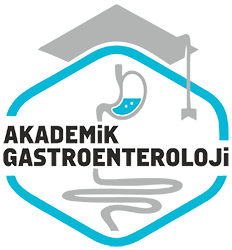Agustos 2011
Portal hipertansiyonda üst gastrointestinal lezyonlar
Upper gastrointestinal lesions in portal hypertension
- Ana Sayfa
- Sayılar
- Agustos 2011
- Portal hipertansiyonda üst gastrointestinal lezyonlar...
Türkiye Yüksek Ihtisas Hastanesi, 2Gastroenteroloji Klinigi, Ankara
Sisli Etfal Egitim ve Arastirma Hastanesi, 3Gastroenteroloji Klinigi, Istanbul
Özet
Portal hipertansiyonlu hastalarda üst gastrointestinal sistemde bulunabilecek portal hipertansiyonla ilişkili lezyonlarin sikligini saptamak ve bu lezyonlarin portal hipertansiyon etyolojisi, kanama öyküsü, Child-Pugh sinifi ve endoskopik tedaviyle ilişkisini araştırmak amaçlariyla bu prospektif çalışma planlanmıştır. Gereç ve Yöntem: Çalışmamıza ortalama yaşlari 47.8±15.3 olan 45’i kadın toplam 128 hasta alındı. Hastalarda, 1) özofagusdan duodenum ikinci kitasina dek varis olup olmadigi, 2) peptik hastalık varligi ve 3) portal hipertansif gastropati ile portal hipertansif duodenopati varligi arastirildi. Bulgular: Hastalar 4 gruba ayrilarak değerlendirildi. Grup-I kanama geçirmemis olanlar (41 hasta), Grup-II kanama geçirmis olup tedavi yapilmamis olanlar (15 hasta), Grup-III tedavi programinda olup özofagus varisleri eradike edilmemis olanlar (41 hasta), Grup-IV özofagus varisleri eradike edilmiş olanlar (31 hasta). Eradikasyon saglanmis olan Grup-IV’deki Hastaların hiçbirinde özofagus varisi bulunmazken, diğer üç gruptaki Hastaların hepsinde vardı (p<0.05). Fundus ve korpus varisleri Grup-I’de diğer 3 gruptan daha seyrekken, kardia varisi Grup-I ve Grup-IV’de diğer 2 gruptan daha seyrekti (p<0.05). Hastaların %83’ünde portal hipertansif gastropati, %26’sinda portal hipertansif duodenopati ve %37.5’inde peptik hastalık saptandi. Idiyopatik portal hipertansiyon ve portal ven trombozu olan hastalarda kardia ve fundus varisi bulunma orani diğer hasta gruplarindan daha fazlaydi (p<0.05). Sonuç: Kanama öyküsü olan, endoskopik tedavi yapılan ve etyolojide idiopatik portal hipertansiyon veya portal ven trombozu bulunan hastalarda portal hipertansiyona ikincil gelişen lezyonlara daha sik rastlanmaktadır.
Abstract
: This prospective study was planned to detect the frequency of portal hypertension-related upper gastrointestinal lesions and the relationship between these lesions and the etiology of portal hypertension, bleeding history, Child-Pugh class, and endoscopic variceal treatment. Materials and Methods: A total of 128 patients (45 female) with a mean age of 47.8±15.3 years were included in the study. In these patients, 1) the presence of varices from the esophagus up to the second portion of the duodenum, 2) the presence of peptic disease and 3) the presence of portal hypertensive gastropathy and duodenopathy were investigated. Results: The patients were divided into 4 groups as follows: Group I, patients without bleeding (41 patients); Group II, patients with bleeding but no endoscopic treatment (15 patients); Group III, patients with endoscopic variceal treatment without eradication (41 patients); and Group IV, patients with esophageal variceal eradication (31 patients). While there were no esophageal varices in Group IV, the other 3 groups all had esophageal varices (p<0.05). While fundus and corpus varices were seen less frequently in Group I according to the other 3 groups, cardia varices were found less commonly in Groups I and IV when compared to the other 2 groups (p<0.05). In the whole study group, portal hypertensive gastropathy was detected in 83%, portal hypertensive duodenopathy in 26% and peptic disease in 37.5%. In patients with idiopathic portal hypertension or portal vein thrombosis, the presence of fundus and cardia varices was found more frequent compared to other etiologies of portal hypertension (p<0.05). Conclusions: Upper gastrointestinal lesions related with portal hypertension were seen more frequently in patients with bleeding and/or endoscopic variceal treatment history and in those with idiopathic portal hypertension or portal vein thrombosis.



